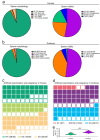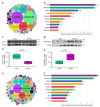Comparative Analysis of Proteomic Characteristics in Seminal Plasma Between Horses and Donkeys
- PMID: 40508997
- PMCID: PMC12153549
- DOI: 10.3390/ani15111532
Comparative Analysis of Proteomic Characteristics in Seminal Plasma Between Horses and Donkeys
Abstract
Horses and donkeys, as integral members of the equine family, exhibit distinct reproductive capabilities and characteristics. Seminal plasma, the fluid component of semen, contains a variety of proteins that play critical roles in sperm function and fertility. This study aimed to systematically compare the protein profiles in the seminal plasma of horses and donkeys, thereby elucidating the molecular differences between these two species. The study utilized 4D-DIA proteomics technology to analyze seminal plasma from horses and donkeys and further validated key proteins through Western blot. Our findings revealed significant variations in seminal plasma protein composition between horses and donkeys. We identified 2380 and 2385 proteins in the seminal plasma of horses and donkeys. Among these proteins, 59 are solely present in the seminal plasma of horses, and 64 uniquely exsit in that of donkeys, respectively. These insights enhance our understanding of the biological mechanisms underlying the reproductive distinctions between these equine species. Moreover, the identified species specific proteins may be essential for thier sperm quality and function, which holds practical value for breeding programs and investigations.
Keywords: 4D-DIA; donkey; equid; horse; pregnancy rate; proteomic profile; seminal plasma.
Conflict of interest statement
The authors declare no conflicts of interest.
Figures








Similar articles
-
Comprehensive Integrated Analyses of Proteins and Metabolites in Equine Seminal Plasma (Horses and Donkeys).Proteomes. 2025 Jul 4;13(3):33. doi: 10.3390/proteomes13030033. Proteomes. 2025. PMID: 40700277 Free PMC article.
-
Comparative Study on the Sperm Proteomes of Horses and Donkeys.Animals (Basel). 2024 Jul 31;14(15):2237. doi: 10.3390/ani14152237. Animals (Basel). 2024. PMID: 39123763 Free PMC article.
-
Proteomic profile of seminal plasma from Pêga donkeys (Equus asinus) with high sperm motility and vigor: Implications for assisted reproduction.Comp Biochem Physiol Part D Genomics Proteomics. 2024 Dec;52:101264. doi: 10.1016/j.cbd.2024.101264. Epub 2024 Jun 27. Comp Biochem Physiol Part D Genomics Proteomics. 2024. PMID: 38991313
-
Seminal fluid and immune adaptation for pregnancy--comparative biology in mammalian species.Reprod Domest Anim. 2014 Sep;49 Suppl 3:27-36. doi: 10.1111/rda.12383. Reprod Domest Anim. 2014. PMID: 25220746 Review.
-
Interaction between equine semen and the endometrium: the inflammatory response to semen.Anim Reprod Sci. 2001 Dec 3;68(3-4):273-8. doi: 10.1016/s0378-4320(01)00164-6. Anim Reprod Sci. 2001. PMID: 11744271 Review.
Cited by
-
Comprehensive Integrated Analyses of Proteins and Metabolites in Equine Seminal Plasma (Horses and Donkeys).Proteomes. 2025 Jul 4;13(3):33. doi: 10.3390/proteomes13030033. Proteomes. 2025. PMID: 40700277 Free PMC article.
References
-
- Ren X., Liu Y., Zhao Y., Li B., Bai D., Bou G., Zhang X., Du M., Wang X., Bou T., et al. Analysis of the Whole-Genome Sequences from an Equus Parent-Offspring Trio Provides Insight into the Genomic Incompatibilities in the Hybrid Mule. Genes. 2022;13:2188. doi: 10.3390/genes13122188. - DOI - PMC - PubMed
Grants and funding
- BR220402/the Basic scientific research operating expenses project of universities directly under the Inner Mongolia Autonomous Region
- NJZY23117/the science and technology research projects of universities In Inner Mongolia Autonomous Region
- DC2300001263/the 2022 annual high-level talent research support fund project for local public institutions in Inner Mongolia Autonomous Region
- NDYB2022-42/the research initiation grant program at Inner Mongolia Agricultural University
LinkOut - more resources
Full Text Sources

